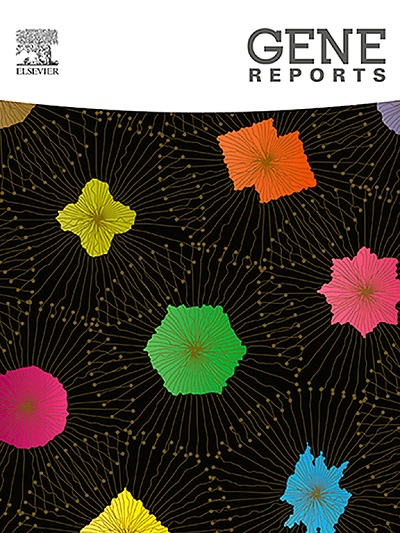Inhibitory effect of dendrosomal-nanocurcumin on Burkitt's lymphoma cells by reducing EBV lytic gene expression
IF 1
Q4 GENETICS & HEREDITY
引用次数: 0
Abstract
Introduction
Epstein-Barr virus (EBV) is a human oncogenic virus that targets B lymphocytes and is associated with some malignancies, such as Burkitt's lymphoma. Curcumin, as a natural product, has anticancer, antiproliferative, and antiviral properties. The combination of curcumin with some nanoparticles, such as dendrosom, can increase its solubility and anti-cancer effects. The present research aims to investigate the antiviral effect of Dendrosomal NanoCurcumin (DNC) on Burkitt's lymphoma cells (Daudi cell line) and the expression of EBV lytic genes and apoptosis.
Materials and methods
The cytotoxicity of curcumin, DNC, and dendrosome on Daudi cells and Peripheral Blood Mononuclear Cells (PBMC) as a control was assessed using a (3-(4, 5-dimethyl thiazolyl-2)-2, 5-diphenyltetrazolium bromide) MTT assay. Cell apoptosis was evaluated by Annexin/PI flow cytometry. RNA expression of BZLF1, BHRF1, and BRLF1 was assessed by quantitative real-time reverse transcription-polymerase chain reaction (qRT-PCR) assay. The t-test was used for statistical analysis.
Results
The half-minimum concentration of cytotoxicity (CC50) for nanocurcumin was 30 μg/ml, for curcumin 50 μg/ml, and for dendrosome 987 μg/ml. DNC caused time and dose-dependent death in Daudi cancer cells compared to curcumin and showed no toxicity in control cells. Quantitative RT-PCR evaluation showed a significant decrease in BZLF1, BHRF1, and BRLF1 mRNA expression at 30 μg/ml concentration of DNC compared to the control. The data obtained from the relative measurement of gene expression showed a decrease in the expression of viral lytic genes (P < 0.001).
Conclusion
In this study, it is noted that carriers, such as dendrosome, enhance the bioavailability of curcumin, thereby increasing its antitumor properties and cell apoptosis. Noteworthy, DNC nanoparticles can serve as a promising drug candidate and supplement in the treatment of Burkitt's lymphoma and in improving patient survival by reducing the expression of EBV lytic phase viral genes.
通过减少 EBV 裂解基因的表达,树枝状蛋白-纳米古柯碱对伯基特淋巴瘤细胞具有抑制作用
导言天疱疮病毒(EBV)是一种针对 B 淋巴细胞的人类致癌病毒,与某些恶性肿瘤(如伯基特淋巴瘤)有关。姜黄素作为一种天然产品,具有抗癌、抗增殖和抗病毒的特性。姜黄素与一些纳米粒子(如石斛素)结合,可增加其溶解度和抗癌效果。本研究旨在探讨 Dendrosomal 纳米姜黄素(DNC)对伯基特淋巴瘤细胞(Daudi 细胞系)的抗病毒作用,以及 EBV 致死基因的表达和细胞凋亡。材料和方法姜黄素、DNC 和 Dendrosome 对 Daudi 细胞和作为对照的外周血单核细胞(PBMC)的细胞毒性采用(3-(4, 5-二甲基噻唑基-2)-2, 5-二苯基溴化四氮唑)MTT 法进行评估。细胞凋亡通过 Annexin/PI 流式细胞术进行评估。BZLF1、BHRF1和BRLF1的RNA表达通过实时定量反转录聚合酶链反应(qRT-PCR)进行评估。结果纳米姜黄素的半数最低细胞毒性浓度(CC50)为 30 μg/ml,姜黄素为 50 μg/ml,树突状细胞为 987 μg/ml。与姜黄素相比,DNC 对 Daudi 癌细胞造成的死亡具有时间和剂量依赖性,而对对照细胞则无毒性。定量 RT-PCR 评估显示,与对照组相比,浓度为 30 μg/ml 的 DNC 会显著降低 BZLF1、BHRF1 和 BRLF1 mRNA 的表达。基因表达的相对测量数据显示,病毒裂解基因的表达量有所下降(P < 0.001)。值得注意的是,DNC 纳米粒子可作为治疗伯基特淋巴瘤的候选药物和辅助药物,通过减少 EBV 溶核期病毒基因的表达,提高患者的生存率。
本文章由计算机程序翻译,如有差异,请以英文原文为准。
求助全文
约1分钟内获得全文
求助全文
来源期刊

Gene Reports
Biochemistry, Genetics and Molecular Biology-Genetics
CiteScore
3.30
自引率
7.70%
发文量
246
审稿时长
49 days
期刊介绍:
Gene Reports publishes papers that focus on the regulation, expression, function and evolution of genes in all biological contexts, including all prokaryotic and eukaryotic organisms, as well as viruses. Gene Reports strives to be a very diverse journal and topics in all fields will be considered for publication. Although not limited to the following, some general topics include: DNA Organization, Replication & Evolution -Focus on genomic DNA (chromosomal organization, comparative genomics, DNA replication, DNA repair, mobile DNA, mitochondrial DNA, chloroplast DNA). Expression & Function - Focus on functional RNAs (microRNAs, tRNAs, rRNAs, mRNA splicing, alternative polyadenylation) Regulation - Focus on processes that mediate gene-read out (epigenetics, chromatin, histone code, transcription, translation, protein degradation). Cell Signaling - Focus on mechanisms that control information flow into the nucleus to control gene expression (kinase and phosphatase pathways controlled by extra-cellular ligands, Wnt, Notch, TGFbeta/BMPs, FGFs, IGFs etc.) Profiling of gene expression and genetic variation - Focus on high throughput approaches (e.g., DeepSeq, ChIP-Seq, Affymetrix microarrays, proteomics) that define gene regulatory circuitry, molecular pathways and protein/protein networks. Genetics - Focus on development in model organisms (e.g., mouse, frog, fruit fly, worm), human genetic variation, population genetics, as well as agricultural and veterinary genetics. Molecular Pathology & Regenerative Medicine - Focus on the deregulation of molecular processes in human diseases and mechanisms supporting regeneration of tissues through pluripotent or multipotent stem cells.
 求助内容:
求助内容: 应助结果提醒方式:
应助结果提醒方式:


